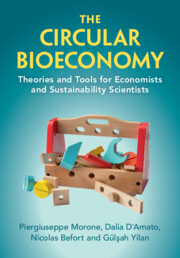Book contents
- The Circular Bioeconomy
- The Circular Bioeconomy
- Copyright page
- Contents
- Figures
- Tables
- Preface
- Acknowledgements
- Note on the Text
- Abbreviations and Notations
- Part I
- Part II
- 4 Environmental Economics and the Bioeconomy
- 5 Sustainability Transition and the Bioeconomy
- 6 The Role of Bioeconomy towards Safe and Just Sustainability Transformations
- Part III
- Index
- References
6 - The Role of Bioeconomy towards Safe and Just Sustainability Transformations
from Part II
Published online by Cambridge University Press: 26 October 2023
- The Circular Bioeconomy
- The Circular Bioeconomy
- Copyright page
- Contents
- Figures
- Tables
- Preface
- Acknowledgements
- Note on the Text
- Abbreviations and Notations
- Part I
- Part II
- 4 Environmental Economics and the Bioeconomy
- 5 Sustainability Transition and the Bioeconomy
- 6 The Role of Bioeconomy towards Safe and Just Sustainability Transformations
- Part III
- Index
- References
Summary
In Chapter 6, the bioeconomy is examined in light of basic notions from the field of ecological economics and sustainability science, such as natural capital substitutability, planetary boundaries, social needs, growth and de/post-growth, justice, and equity. Overall, such notions highlight the need to pursue sustainability solutions that are simultaneously safe for planetary ecological health and just for people across space and time.
Keywords
- Type
- Chapter
- Information
- The Circular BioeconomyTheories and Tools for Economists and Sustainability Scientists, pp. 107 - 122Publisher: Cambridge University PressPrint publication year: 2023



